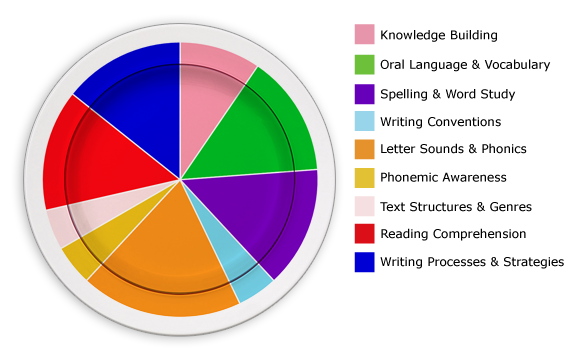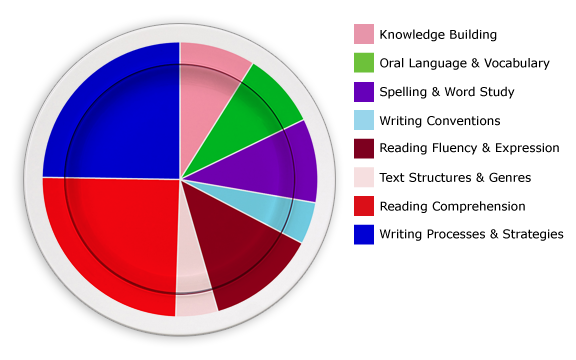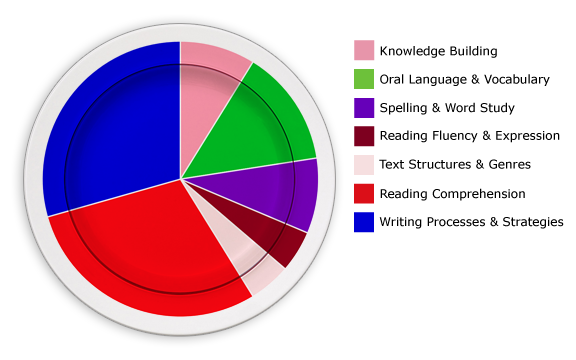Stages of Literacy Development
How "Nutritional Needs" Change with Growth in Literacy
"Healthy Plates" for Literacy
Just as with a healty diet the amount and type of food children require for growth in literacy changes as they develop. In the elementary grades students normally pass through the following four Stages of Literacy Development:
Stage 0: Foundation for Literacy
Stage 1: Beginning Literacy
Stage 2: Consolidation / Fluency
Stage 3: Literacy for Growth
Stage 0:Foundation for Literacy

Stage 1:Beginning Literacy

Stage 2:Consolidation/Fluency

Stage 3: Literacy for Growth

What Should Go On The Healthy Plate?
Within the Balanced Literacy Diet metaphor a useful concept is that human dietary requirements change at different stages. Students need to consume the right balance of the food groups in order to grow in literacy and that balance changes as they develop proficiency in reading and writing. The essential food groups to ensure growth in literacy are shown in the "Healthy Plates" at the left. Through informal experiences and formal instruction teachers and caregivers must provide enough of these essential "foods for literacy" to ensure stage-appropriate progress. The details of how to teach and assess these key food groups are provided in their respective Food Groups pages.
Stage 0: Foundation for Literacy
At the earliest stages of literacy development it is important to introduce young children to the wonders and power of the printed word – sharing the delights of books and showing how language can be written down with letters so that others can read what we have written. This foundational stage normally begins in the home and extends into the earliest years of school. Parents, early childhood educators, and prek teachers can do much to prepare young children for reading and writing through shared book experiences designed to facilitate children's understanding of the connections between oral language and print. Some key literacy diet food groups at this stage are: oral language development, concepts of print, phonemic awareness, and letter-sound correspondences. Most children are ready to move on to Stage 1, the more serious business involved in learning to read and write, sometime in kindergarten.
Stage 1: Beginning Literacy
This stage is when students move from learning about reading and writing to actually doing it. At this point they need to learn how the system works and must be taught more explicitly and systematically how individual letters and letter groupings represent a code. This empowers them to decode (read) words by blending sounds together and to encode (spell) words by identifying sounds in spoken words and representing them in print. Using the code they can write down anything they can say (sometimes using “inventive spellings”) and read back what they and others have written. Students also need to learn to read and spell common, irregularly spelled, words so that they can recognize them easily when reading, and spell them effortlessly in writing. In order to become confident readers they need to have lots of practice reading appropriately selected “leveled” books that combine decodable and high frequency words, allowing them to apply what they have been taught in manageable tasks. Engaging in meaningful reading and writing activities daily builds their competence and enjoyment.
Stage 2: Consolidation / Fluency
This stage is when students must consolidate what they learned in Stage 1 and be able to apply their skills with less effort. Until they achieve some fluency, reading and writing represent work for students. The effort of dealing with "the mechanics" detracts from their thinking about the ideas in text. Reading and writing fluency come with practice. In order for students to build reading fluency and expression, they need to read for extended periods and it is important that what they read is interesting and not too challenging. At this stage reading aloud to a partner is an effective way to build fluency. With writing as well, students need to have many opportunities to practice: the more they write the easier it gets. Until they are fluent writers the demands of letter formation, spelling and sentence construction take away from the richness of their compositions. Once students become more fluent in their skills, they can think more deeply about the content of what they read and write.
Stage 3: Literacy for Growth
Stages 0, 1 and 2 build students' competence and confidence as readers and writers. In Stage 3 they extend and apply their literacy skills. They use reading and writing as a means of acquiring new information, conducting research, reflecting on issues and communicating about deeper thoughts and feelings. At this point instruction in more complex reading comprehension and written composition strategies will advance their sophistication as readers and writers. Students are ready to begin reflecting on higher level considerations such as audience, author's purpose, uses of text structure to organize and communicate, and the power of word choice in nuancing the meaning conveyed in text. Whereas in the earlier stages students are learning to read and write, in Stage 3 and beyond they are using reading and writing to grow their intellect.
What it Looks Like
To be effective, teachers need to understand the requirements of the stages and provide their students with stage-appropriate "foods for literacy." Educators who understand this complexity are well prepared to teach the vast majority of students in their classrooms and to provide differentiated instruction for those who need ‘special literacy diets’ because of learning disabilities.
Read more about Stages of Literacy Development
What should be emphasized at each stage of reading development?
Listen to Dr. Louisa Moats describe each of Dr. Jeanne Chall's Stages of Reading
Invented Spelling and Spelling Development
Literacy Expectations Across the Primary Grades
Goals for Preschool: Awareness and Exploration
Goals for Kindergarten: Experimental Reading and Writing
Goals for First Grade: Early Reading and Writing
Goals for Second Grade: Transitional Reading and Writing








